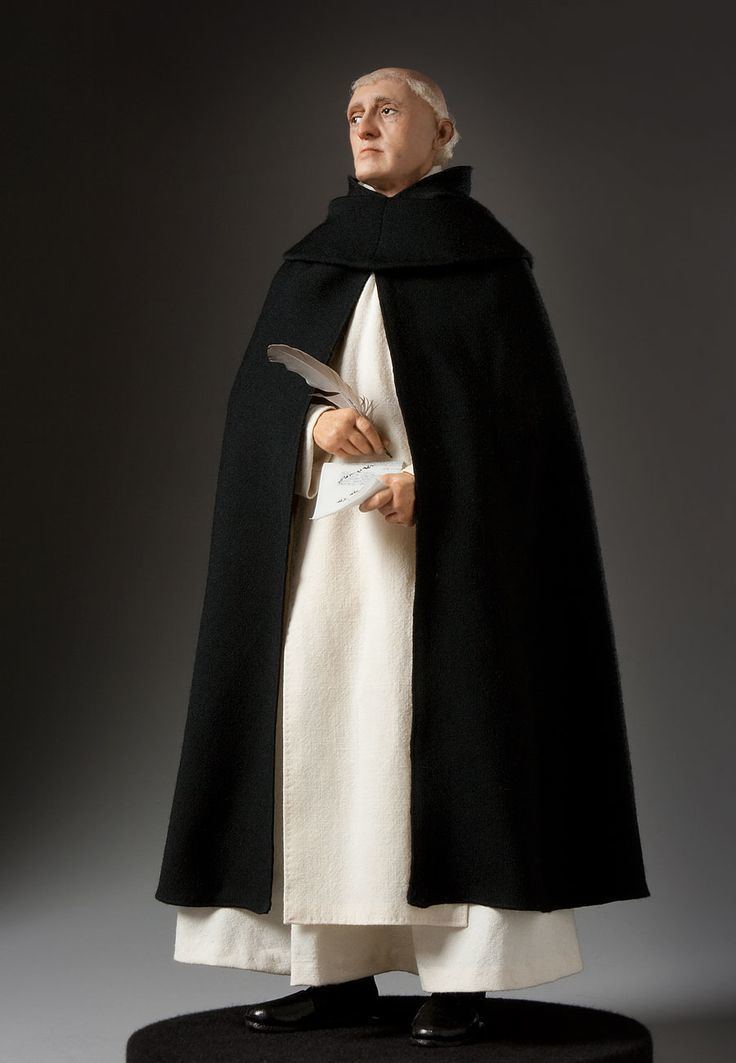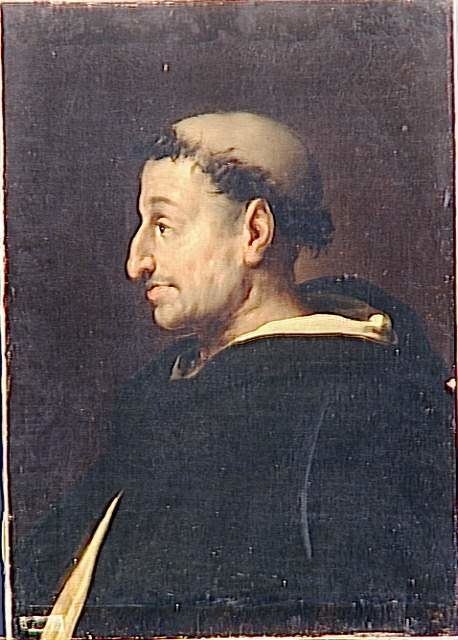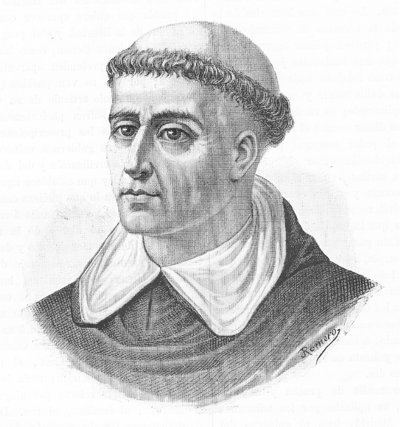Name Tomas Torquemada | ||
 | ||
Religion Christian-Roman Catholic Died September 16, 1498, Avila, Spain Similar People Isabella I of Castile, Christopher Columbus, Saint Dominic, John - Prince of Asturias, Lance Henriksen | ||
Tom s de torquemada
Tomás de Torquemada (Thomas of Torquemada), O.P. (/ˌtɔːrkəˈmɑːdə/ [toɾkeˈmaða]; 1420 – September 16, 1498) was a Castilian Dominican friar, and the first Grand Inquisitor in Spain's movement to homogenize religious practices with those of the Catholic Church in the late 15th century, otherwise known as "The Spanish Inquisition."
Contents
- Tom s de torquemada
- Tom s de torquemada el gran inquisidor
- Early life
- Establishment of the Holy Office of the Inquisition
- Grand Inquisitor
- Death
- In fiction
- References

Mainly because of persecution, Muslims and Jews in Spain at that time found it socially, politically, and economically expedient to convert to Catholicism, (see Converso, Morisco, and Marrano). Large in number, the existence of superficial converts, (i.e., Crypto-Jews), was perceived by the Spanish monarchs of that time, (principally King Ferdinand and Queen Isabella), as a threat to the religious and social life of Spain. This led Torquemada, who himself had converso ancestors, to be one of the chief supporters of the Alhambra Decree that expelled the Jews from Spain in 1492.

Tom s de torquemada el gran inquisidor
Early life

Torquemada was born in 1420, either in Valladolid, Old Castile, in the Kingdom of Castile, or in the nearby small village of Torquemada. He came from a family of conversos (converts from Judaism); his uncle, Juan de Torquemada, was a celebrated theologian and cardinal, whose grandmother was a conversa. The contemporary historian, Hernando del Pulgar, (himself a converso) recorded that Tomás de Torquemada's uncle, Juan de Torquemada, had an ancestor, Álvar Fernández de Torquemada, who was married to a first-generation conversa.

Hernando del Pulgar, in his book Claros varones de Castilla, says of Torquemada, «sus abuelos fueron de linage de los Judios convertidos á nuestra Santa Fé Católica» ("His grandparents were of the lineage of the Jews converted to our Holy Catholic faith").

Torquemada entered the local San Pablo Dominican monastery at a very young age. As a zealous advocate of church orthodoxy, he earned a solid reputation for learning, piety, and austerity. As a result, he was promoted to prior of the monastery of Santa Cruz at Segovia. Around this time, he met the young Princess Isabella I, and the two immediately established religious and ideological rapport. For a number of years, Torquemada served as her regular confessor and personal advisor. He was present at Isabella’s coronation in 1474, and remained her closest ally and supporter. He even advised her to marry King Ferdinand of Aragon in 1469, in order to consolidate their kingdoms and form a power base he could draw on for his own purposes.
Establishment of the Holy Office of the Inquisition

Torquemada deeply feared the Marranos and Moriscos as a menace to Spain's welfare by both their increasing religious influence, and their economic domination of Spain. The Crown of Aragon had Dominican inquisitors almost continuously throughout much of the fourteenth and fifteenth centuries. King Ferdinand and Queen Isabella petitioned Pope Sixtus IV to grant their request for a Holy Office to administer an inquisition in Spain. The Pope granted their request, and established the Holy Office for the Propagation of the Faith in late 1478. The papal bull gave the sovereigns full powers to name inquisitors. Rome retained the right to formally appoint the royal nominees. Henry Charles Lea observed that the Spanish Inquisition in both Castile and Aragon remained firmly under Ferdinand's direction throughout the joint reign.
Grand Inquisitor
The Pope went on to appoint a number of inquisitors for the Spanish Kingdoms in early 1482, including Torquemada. A year later he was named Grand Inquisitor of Spain, which he remained until his death in 1498. In the fifteen years under his direction, the Spanish Inquisition grew from the single tribunal at Seville to a network of two dozen 'Holy Offices.' As Grand Inquisitor, Torquemada reorganized the Spanish Inquisition (originally based in Castile in 1478), establishing tribunals in Sevilla, Jaén, Córdoba, Ciudad Real, and (later) Saragossa. His quest was to rid Spain of all heresy. The Spanish chronicler, Sebastián de Olmedo, called him "the hammer of heretics, the light of Spain, the savior of his country, the honor of his order."
Torquemada saw that the condemned were made to wear a sanbenito, a penitential garment worn over clothing, bearing a design that specified the type of penitence, if any. One type, worn by those sentenced to death, had designs of hell’s flames, or sometimes demons, dragons, and/or snakes on it. Another type had a cross, and was worn instead of imprisonment, then hung in the parish church.
The Treaty of Granada (1491), as negotiated at the final surrender of the Muslim state of Al-Andalus, clearly mandated protection of religious rights, but this was reversed just over 3 months later by the Alhambra Decree of March 31, 1492. Under the new Decree, approximately 40,000 Jews were expelled from Spain with only their personal possessions. Another approximately 50,000 Jews received a Christian baptism so as to remain in Spain; many of these, derogatorily dubbed "Marranos" (literally, "Swines") by the Old Christian majority, secretly kept some of their Jewish traditions. They were one of the chief targets of the Inquisition, but it also pursued anyone who would criticize it.
There is some disagreement as to the number of victims of the Spanish Inquisition during Torquemada's reign as Grand Inquisitor. Some scholars, such as Henry Kamen, believe Torquemada to be responsible for the death of 2,000 people. Hernando del Pulgar, Queen Isabella’s secretary, wrote that 2,000 executions took place throughout the entirety of her reign, which extended well beyond Torquemada's death.
Death
During his final years, Torquemada's failing health, coupled with widespread complaints, caused Pope Alexander VI to appoint four assistant inquisitors in June 1494 to restrain the Spanish Inquisition. After fifteen years as Spain's Grand Inquisitor, Torquemada died in the monastery of St. Thomas Aquinas in Ávila in 1498, and was interred there. His tomb was ransacked in 1832—only two years before the Inquisition was finally disbanded. His bones were allegedly stolen and ritually incinerated as though an auto da fe took place.
